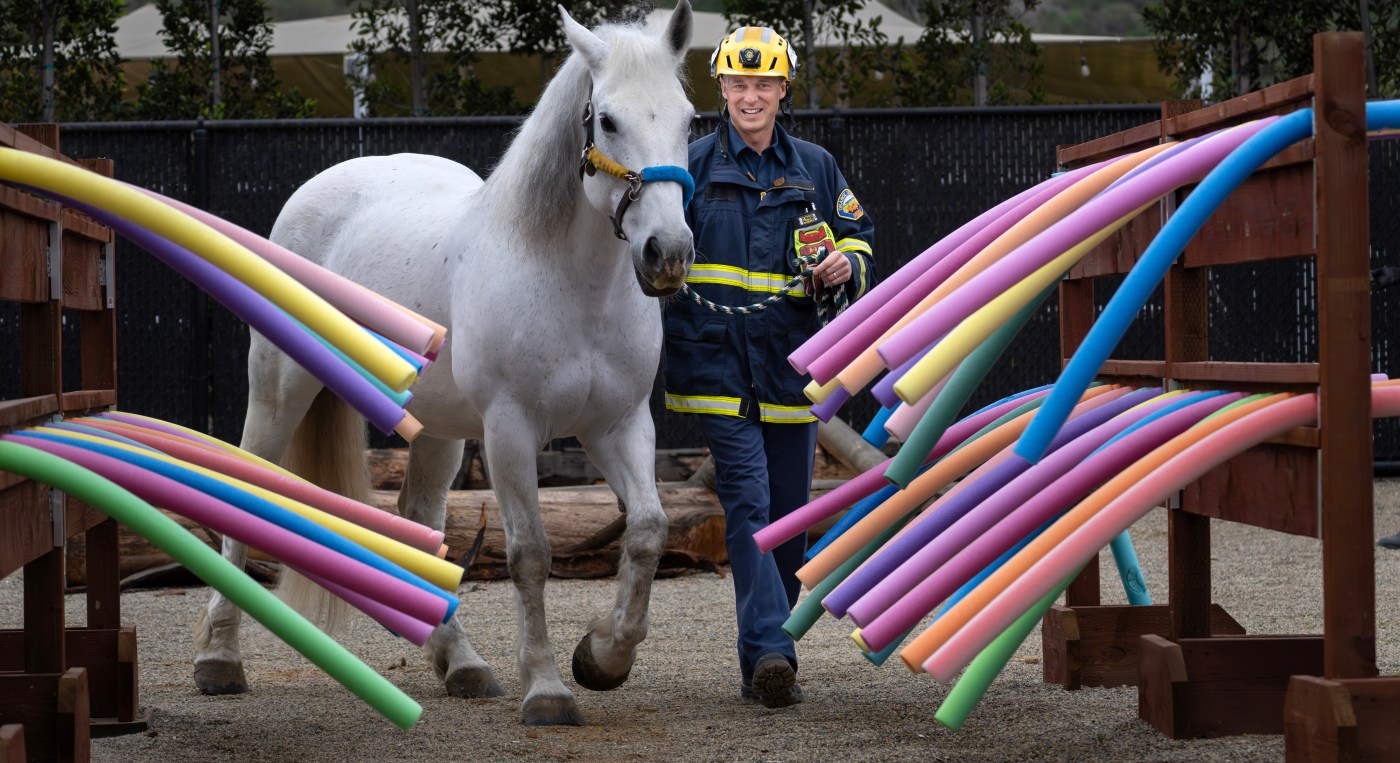An Orange County Fire Authority Urban Search and Rescue team recently rescued a horse that had fallen 20 feet into a ravine and was trapped by vegetation and trees near a San Juan Capistrano riding trail.
Firefighter Chris Harper, 39, part of the first-arriving rescue truck, said he wasn’t really familiar with horses and the crew relied on the expertise of its engineer who rides in his off time on how to best handle preparing the large animal for airlift by a helicopter. Once a veterinarian sedated the horse, the team got to work, and in the end, Deuce, a 22-year-old former show horse, was saved.
“I’ve been a firefighter for 16 years, and I think this was maybe the coolest call I’ve ever been on,” Harper said.
On Wednesday, March 26, he spent the day learning a lot more about rescuing horses in a training event at the J. F. Shea Therapeutic Riding Center in San Juan Capistrano that helps firefighters become more familiar with the large animals.
“Saving an animal like that, being in such close proximity to such an animal in a dynamic situation, hoisting him out with a helicopter and having a good outcome,” Harper said, “it was great.”
Harper, his crew and more than 100 other Search and Rescue firefighters from the OCFA and other city fire departments this week are learning more about how to handle horses in stressful situations.
The center in San Juan Capistrano is known for its therapeutic riding programs for children and adults with disabilities and veterans. But this week, it offered 15 of its horses as well as staff and volunteers, to help with the firefighter training program, which is aided by a $40,000 grant from the Gary Sinise Foundation.
The training, now in its fourth year, includes practicing harnessing a horse for airlifting, placing a horse on a slide so it can be pulled to safety when firefighters use a rope system, learning how to handle a tipped-over trailer and how to free a horse inside, getting anatomy lessons from equine veterinarians and walking horses through an obstacle course. A mannequin horse is used for some of the training.
“To take care of the horses the way you do is a real blessing,” Dana Butler-Moburg, the center’s CEO, told the firefighters gathered for training. San Juan Capistrano has California’s highest per capita ratio of horses to people, at about 1 to 23, and there are hundreds more that reside in Orange County’s equestrian communities, she said, pointing out the usefulness of the training.
Butler-Moburg said the firefighter training program, believed to be the only of its kind in the country, was created following an event that could have turned tragic for one of the center’s therapy horses.
In 2021, Choco was being ridden on a trail when something spooked the animal and he fell into a steep ravine. He ended up being upside down with his legs in the air.
OCFA firefighters sent multiple crews and, after digging him out from under concrete and exposed rebar, they created their own harness and flew him inverted to a cleared landing zone. Firefighters got him upright and Choco was able to walk out on his own power.
After that rescue — Choco is doing well and now retired — Butler-Moburg said she spoke with OCFA Capt. Danny Goodwin and asked about how the agency trains for the large animal rescues. When she found out the firefighters were using a large plastic horse, she had a better idea. Why not train with live horses? So together with Goodwin, Butler-Moburg and her team designed the curriculum.
It started with firefighters just walking horses, Goodwin said. But as incidents informed more of their needs, the curriculum was expanded, such as including training with the trailers.
“We weren’t used to backing a horse out of a trailer,” Goodwin. “As we have dynamic calls, we incorporate those into the curriculum.”
In 2022, Shea held its first firefighter training and more than 100 firefighters came out.
This year, the course is all about increasing confidence for the firefighters handling the horses, Goodwin said.
“Now that we’ve had four years with the same individuals, they build on muscle memory and taking the horses through different situations,” he said. “We will have an incident where we have to lead a horse through a difficult path, so that’s what we’re building up to right now.”
That was Harper’s challenge on Wednesday. This year is his first time going through the Shea training program and the horse obstacle path, which included taking a horse up and down stairs.
Harper got his chance with two horses. Warrior, a Gypsy Vanner, wasn’t too keen on going up the stairs and fought it. But Harper remained calm and in control, talking gently to the horse while placing his hands on the rope just as he had been told and keeping control of the horse’s neck.
“I was trying to be very aware of where I was standing and how to introduce myself to the horse,” Harper said. “I basically tried to treat it like a large dog.
“But now I understand how to speak to a horse, how they follow our body, where they want to be touched, where they don’t want to be touched,” he said. “All those things we learned today will translate to us having a smoother call when we show up to an emergency.”











